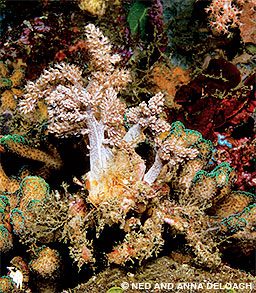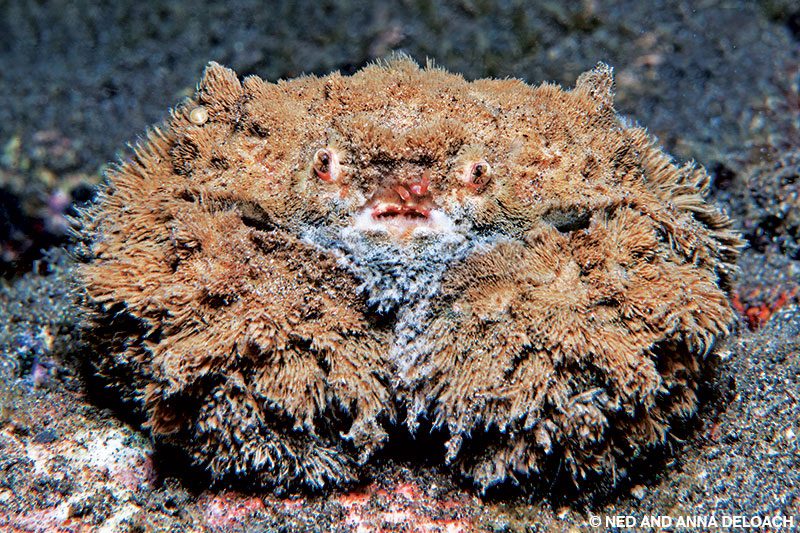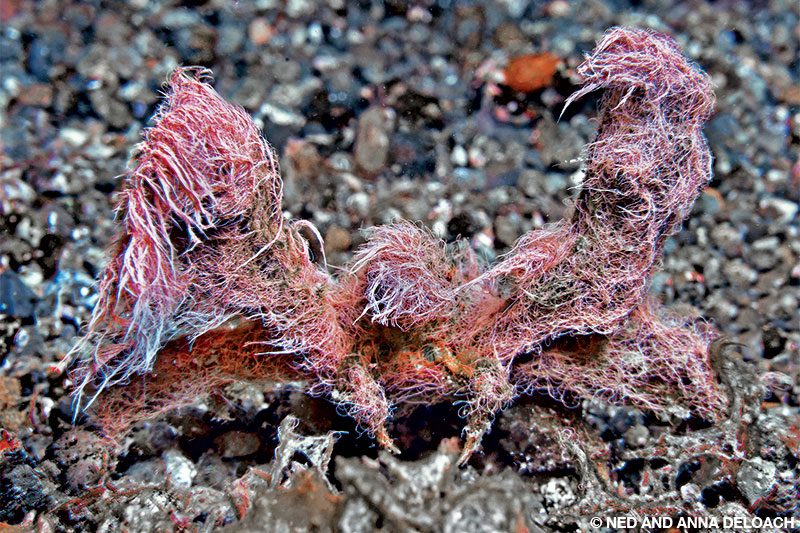A decade or so ago, Anna and I spent the better part of three years photographing octopuses, crabs, shrimp and a multitude of other spineless creatures for a marine life field guide. Our biggest challenge was finding life forms that have evolved to remain hidden. Many of the illusionists are nocturnal and only creep out from their hiding places after sunset to feed, which meant a lot of night diving.
Much of our adventure unfolded in Indonesia’s Lembeh Strait — a hot spot of marine biodiversity in the western Pacific. The famed 10-mile strait provided just what we needed: easy access to a variety of underwater habitats and veteran dive guides with the wherewithal to track down an assortment of unconventional animals.

Each evening Anna and I joined Liberty Tukunang, Ben Sarinda, or both aboard a wooden water taxi retrofitted for diving. Consistent and persistent, our little team invariably set out at 6 p.m. for a pair of two-hour dives night after night for weeks on end. The hunting was so good that no one dared to skip an evening for fear of what they might miss. During this extraordinary time, Anna and I discovered decorator crabs and their amazing ability to hide in plain sight. I can still remember the first crab I couldn’t see.
I didn’t have my aha moment for almost a minute after Ben began repeatedly pointing his muck stick at what seemed to be nothing — at least nothing my citified eyes could see. I just stared stupidly, squinting and blinking at a reef ledge quilted with life. Then, ever so subtly, a claw moved, a whisker twitched, eyes appeared, and a 4-inch crab cloaked in algae and crowned with a branch of soft coral popped into focus. With that single eye-opening encounter, decorator crabs soared to the top of our already lengthy most-wanted list.
As we learned, most decorator crabs belong to one of eight families in the superfamily Majoidea, commonly referred to as spider crabs. About 75 percent of the group’s more than 1,100 global species mask their presence by wearing disguises made from living organisms scissored from the landscape. They commonly hijack seaweeds, sponges, tunicates, bryozoans and hydroids. Most detainees survive the ordeal and continue to grow, and a few even reproduce.
The crabs manipulate the purloined pieces of attire with their mouths before attaching them to one of the many fishhook-shaped bristles arranged in rows on the carapace, rostrum, walking legs and claw arms, depending on the species. The process is not hurried; in aquariums it takes around eight hours for a decorator crab to complete the task. They will also redecorate after molting, typically reattaching materials from sloughed shells to their new, enlarged exoskeletons during the hours required for their armor to harden.
Meat-packed spider crabs are prime targets for a long list of carnivores, including fishes, lobsters, octopuses, turtles, sea otters, gulls and other crabs. Based on limited predation observations in the field and aquaria, decorating appears to be a successful strategy for minimizing the carnage. Although quite effective by night, the camouflage appears to be even more advantageous during the day when the crabs hunker down following an evening of foraging.

These motionless daytime decorators are the dickens to find, but they can be found. Liberty proved the point one morning by tickling out an exquisite specimen cloaked in hydroids. The discovery wasn’t a fluke. As he explained later, the hydroid colony seemed out of place, so on a hunch he nudged it, causing the concealed crab to move. In our effort to explore alternate habitats, we searched the seaward flumes of dry river beds, where the tedium of turning over stones in the end proved quite productive. Everybody’s favorite find was a toylike teddy bear crab shrouded in algae as soft as a whisper.
We took great pride in figuring out how to detect decorators. Each sighting became an event. It quickly became apparent that the crabs were more plentiful, diverse and outrageous than we had imagined. Soon we began noticing variations on the decorators’ successful strategy. Carry crabs tote urchins, sea stars and jellyfish across the sand, sponge decorators hide beneath clipped sponge wedges, and boxer crabs attach miniature anemones to their claws.

As difficult as decorator crabs are to find, once you see through their disguises, your work is done. With no other effective means of defense, the crabs freeze, allowing you to admire them at your leisure. But with nature there are always anomalies, such as the lavender algae crab of Beangabang Bay. Upon discovery, the spindly 3-inch decorator went on a rampage, changing itself into a slapstick image of a ghost attempting to be big and bad, making a perfect Halloween card.
Jelajahi Lebih Lanjut
See decorator crabs in action in this video.
© Alert Diver — Q1 2021